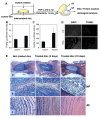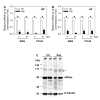An organ culture system to model early degenerative changes of the intervertebral disc
- PMID: 22018279
- PMCID: PMC3308106
- DOI: 10.1186/ar3494
An organ culture system to model early degenerative changes of the intervertebral disc
Abstract
Introduction: Back pain, a significant source of morbidity in our society, is related to the degenerative changes of the intervertebral disc. At present, the treatment of disc disease consists of therapies that are aimed at symptomatic relief. This shortcoming stems in large part from our lack of understanding of the biochemical and molecular events that drive the disease process. The goal of this study is to develop a model of early disc degeneration using an organ culture. This approach is based on our previous studies that indicate that organ culture closely models molecular events that occur in vivo in an ex vivo setting.
Methods: To mimic a degenerative insult, discs were cultured under low oxygen tension in the presence of TNF-α, IL-1β and serum limiting conditions.
Results: Treatment resulted in compromised cell survival and changes in cellular morphology reminiscent of degeneration. There was strong suppression in the expression of matrix proteins including collagen types 1, 2, 6 and 9, proteoglycans, aggrecan and fibromodulin. Moreover, a strong induction in expression of catabolic matrix metalloproteinases (MMP) 3, 9 and 13 with a concomitant increase in aggrecan degradation was seen. An inductive effect on NGF expression was also noticed. Although similar, nucleus pulposus and annulus fibrosus tissues showed some differences in their response to the treatment.
Conclusions: Results of this study show that perturbations in microenvironmental factors result in anatomical and gene expression change within the intervertebral disc that may ultimately compromise cell function and induce pathological deficits. This system would be a valuable screening tool to investigate interventional strategies aimed at restoring disc cell function.
Figures






Similar articles
-
An organ culture system to model early degenerative changes of the intervertebral disc II: profiling global gene expression changes.Arthritis Res Ther. 2013;15(5):R121. doi: 10.1186/ar4301. Arthritis Res Ther. 2013. PMID: 24171898 Free PMC article.
-
Piperine mediates LPS induced inflammatory and catabolic effects in rat intervertebral disc.Int J Clin Exp Pathol. 2015 May 19;8(6):6203-13. eCollection 2015. Int J Clin Exp Pathol. 2015. PMID: 26261497 Free PMC article.
-
Mechanical destabilization induced by controlled annular incision of the intervertebral disc dysregulates metalloproteinase expression and induces disc degeneration.Spine (Phila Pa 1976). 2012 Jan 1;37(1):18-25. doi: 10.1097/BRS.0b013e31820cd8d5. Spine (Phila Pa 1976). 2012. PMID: 22179320
-
Defects in intervertebral disc and spine during development, degeneration, and pain: New research directions for disc regeneration and therapy.Wiley Interdiscip Rev Dev Biol. 2019 Jul;8(4):e343. doi: 10.1002/wdev.343. Epub 2019 Apr 11. Wiley Interdiscip Rev Dev Biol. 2019. PMID: 30977275 Free PMC article. Review.
-
Structure, function, aging and turnover of aggrecan in the intervertebral disc.Biochim Biophys Acta. 2014 Oct;1840(10):3181-9. doi: 10.1016/j.bbagen.2014.07.013. Epub 2014 Jul 24. Biochim Biophys Acta. 2014. PMID: 25065289 Review.
Cited by
-
The mitochondria-targeted anti-oxidant MitoQ protects against intervertebral disc degeneration by ameliorating mitochondrial dysfunction and redox imbalance.Cell Prolif. 2020 Mar;53(3):e12779. doi: 10.1111/cpr.12779. Epub 2020 Feb 5. Cell Prolif. 2020. PMID: 32020711 Free PMC article.
-
Lumbar endplate microfracture injury induces Modic-like changes, intervertebral disc degeneration and spinal cord sensitization - an in vivo rat model.Spine J. 2023 Sep;23(9):1375-1388. doi: 10.1016/j.spinee.2023.04.012. Epub 2023 Apr 21. Spine J. 2023. PMID: 37086976 Free PMC article.
-
The role of biomechanical factors in models of intervertebral disc degeneration across multiple length scales.APL Bioeng. 2023 May 8;7(2):021501. doi: 10.1063/5.0137698. eCollection 2023 Jun. APL Bioeng. 2023. PMID: 37180733 Free PMC article. Review.
-
Intervertebral disc degenerative changes after intradiscal injection of TNF-α in a porcine model.Eur Spine J. 2015 Sep;24(9):2010-6. doi: 10.1007/s00586-015-3926-x. Epub 2015 Apr 8. Eur Spine J. 2015. PMID: 25850392
-
Preclinical ex-vivo Testing of Anti-inflammatory Drugs in a Bovine Intervertebral Degenerative Disc Model.Front Bioeng Biotechnol. 2020 Jun 10;8:583. doi: 10.3389/fbioe.2020.00583. eCollection 2020. Front Bioeng Biotechnol. 2020. PMID: 32587853 Free PMC article.
References
-
- Boden SD, Davis DO, Dina TS, Patronas NJ, Wiesel SW. Abnormal magnetic-resonance scans of the lumbar spine in asymptomatic subjects. A prospective investigation. J Bone Joint Surg Am. 1990;72:403–408. - PubMed
Publication types
MeSH terms
Grants and funding
LinkOut - more resources
Full Text Sources

